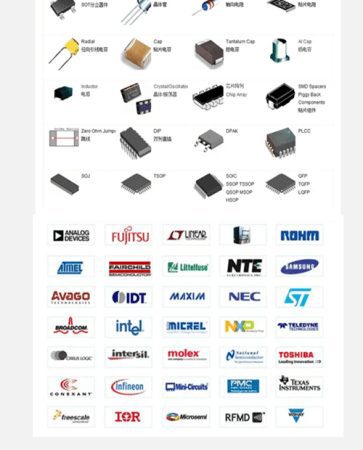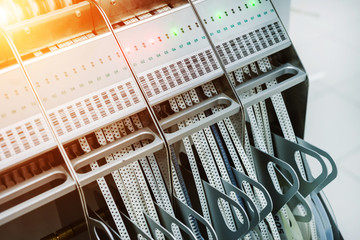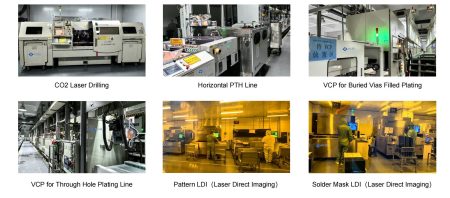- +86-755-23012705
- Building 3, Jinfeng Industrial Park, Fuyong Street, Baoan District, Shenzhen ,China
- [email protected]
Menu
Surface Mount Devices (SMDs) have become the standard in modern electronic assembly due to their compact size, ease of automated assembly, and high performance. These components are mounted directly on the surface of a printed circuit board (PCB), unlike through-hole components that require drilled holes. SMD components come in a wide range of types, each designed for specific functions and applications. In this blog, we will dive into the classification of SMD components, discussing the key types and their typical uses in modern electronics.
Resistors are among the most common and essential SMD components. These are used to limit current flow, divide voltages, and protect other components from excessive current. In the SMD form, resistors come in small, rectangular packages and are typically identified by their size and resistance value.
0603 (Metric: 1608): One of the most compact resistor sizes, commonly used in smartphones and wearable electronics.
0805 (Metric: 2012): A standard size used in a wide range of applications, offering a balance between size and power handling.
1206 (Metric: 3216): A larger package that allows for higher power dissipation, often used in automotive and industrial applications.
These SMD resistors are chosen based on factors like required resistance, power rating, and available PCB space.
SMD capacitors are used for energy storage, filtering, and smoothing in circuits. They come in a variety of types, each designed for specific uses such as power supply filtering, signal coupling, and decoupling. Capacitors are classified by their material composition and intended function.

Ceramic Capacitors: The most widely used SMD capacitors, made from ceramic materials. They are small, inexpensive, and come in different dielectric materials, such as X7R and C0G, depending on their temperature stability and capacitance range.
Tantalum Capacitors: Known for their high capacitance and stable performance, tantalum capacitors are typically used in higher-capacitance applications where space is limited.
Electrolytic Capacitors: Though less common in SMD, these are used for high capacitance values and are generally employed in power supplies and energy storage applications.
SMD capacitors are available in similar sizes to resistors (e.g., 0603, 0805, 1206) and are selected based on their capacitance value, voltage rating, and tolerance.
Inductors in SMD form are typically used in power supplies, signal filtering, and energy storage applications. They store energy in a magnetic field when current flows through them. SMD inductors come in various sizes and designs, each suited for different purposes.
Surface-Mount Power Inductors: These inductors are used in power conversion circuits, such as DC-DC converters. They are designed to handle higher currents and are typically found in devices like smartphones and laptops.
Signal Inductors: These are used for filtering and are typically found in radio-frequency (RF) applications. They are designed to handle lower currents but can be very precise in their inductance.
The choice of inductor depends on the required inductance value, current capacity, and the physical space available on the PCB.
Diodes are semiconductor components used to allow current to flow in one direction only, providing rectification, voltage regulation, or protection. In SMD form, diodes are compact and widely used in a variety of electronic circuits, including power supplies, communication devices, and signal processing.
Rectifier Diodes: Used in power supply circuits to convert alternating current (AC) to direct current (DC).
Zener Diodes: Used for voltage regulation in circuits, ensuring a constant output voltage.
Schottky Diodes: Known for their low forward voltage drop, they are used in high-speed switching applications.
SMD diodes come in packages like SOD-123 and SOD-323, each tailored to different current handling capabilities and voltage ratings.
Transistors are crucial components in modern electronics, acting as switches or amplifiers. SMD transistors are used in a variety of applications, including signal amplification, voltage regulation, and as switches in digital circuits.
NPN and PNP Transistors: Used for switching and amplification in analog and digital circuits.
MOSFETs (Metal-Oxide-Semiconductor Field-Effect Transistors): Widely used for switching and amplification, particularly in high-speed and low-voltage applications.
Junction Field-Effect Transistors (JFETs): Used in analog signal processing and high-frequency applications.
SMD transistors are typically available in small packages such as SOT-23, SOT-89, or more complex configurations like the QFN or BGA for higher-power devices.

Integrated Circuits (ICs) are one of the most common SMD components, used for tasks ranging from simple logic functions to complex processing tasks. These components can range from microcontrollers and processors to memory chips and power management ICs.
Logic ICs: Used for performing basic logic operations like AND, OR, NOT, etc.
Microcontrollers: Used in embedded systems for controlling electronic devices.
Voltage Regulators: Used to maintain stable voltage levels in circuits.
Op-Amps (Operational Amplifiers): Widely used for signal conditioning, amplification, and filtering.
ICs come in a variety of package types such as SOIC (Small Outline Integrated Circuit), QFP (Quad Flat Package), BGA (Ball Grid Array), and more, with different numbers of pins to meet the needs of various applications.
SMD connectors and switches are used to provide electrical connections between components on the PCB or with external devices. These include small buttons, slide switches, and headers that can be used in low-voltage or high-frequency circuits.
Push-Button Switches: Common in user interface applications, used in consumer electronics like remotes or toys.
Micro Connectors: Often used for data and power connections in compact devices.
Slide Switches: Used for turning circuits on or off in smaller devices.
These components are chosen based on their functionality, size, and the type of connection required.

SMD components are the backbone of modern electronic designs. Their small size and versatility make them ideal for use in compact, high-performance devices. From resistors, capacitors, and inductors to complex ICs, diodes, and transistors, SMD components offer a wide array of functions to meet the needs of various industries. By understanding the classification and characteristics of these components, engineers and designers can make informed decisions when selecting the right parts for their electronic products, ensuring optimal performance and reliability in their designs.
Discover a World of Possibilities with XPCB Limited
At XPCB Limited, we’re here to help you explore new horizons. Our advanced PCB manufacturing, rapid prototyping, and turnkey PCBA solutions make it easy for you to turn your ideas into reality. Trust us to deliver excellence and reliability every step of the way. Join us and experience the power of innovation with XPCB Limited by your side.






XPCB Limited is a premium PCB & PCBA manufacturer based in China.
We specialize in multilayer flexible circuits, rigid-flex PCB, HDI PCB, and Rogers PCB.
Quick-turn PCB prototyping is our specialty. Demanding project is our advantage.
Tel : +86-136-3163-3671
Fax : +86-755-2301 2705
Email : [email protected]
© 2024 - XPCB Limited All Right Reserve
